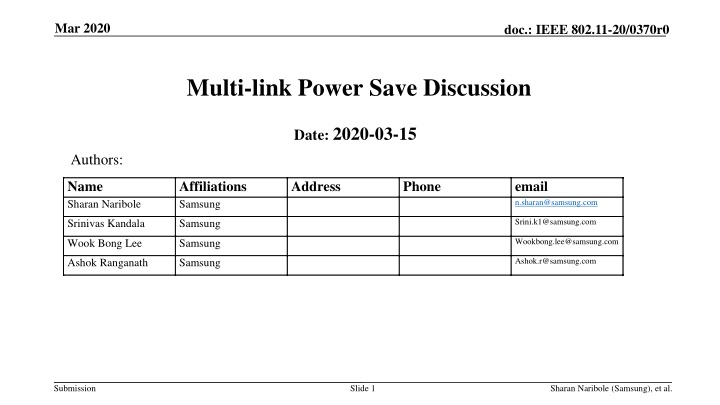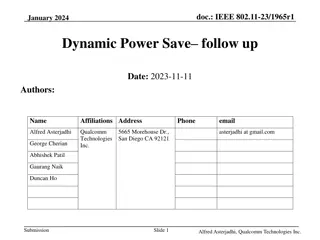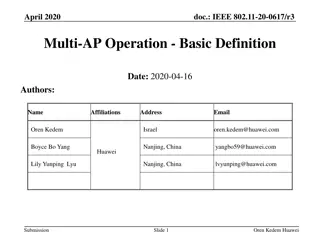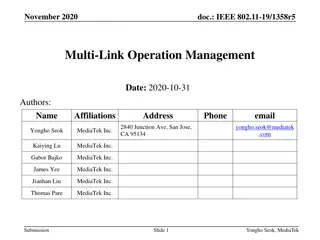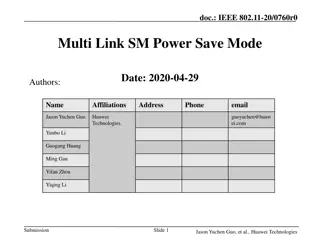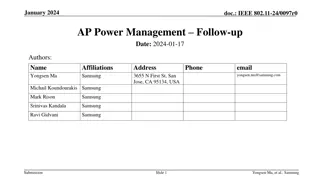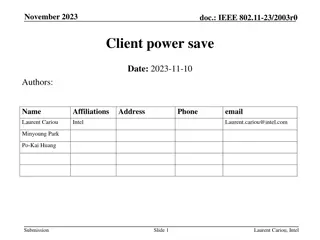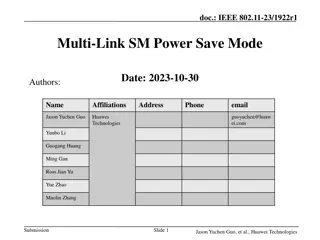IEEE 802.11-20/0370r0 Multi-link Power Save Discussion
The document discusses multi-link power saving in the IEEE 802.11be standard. It reviews extreme low power multi-link operation modes, emphasizing the importance of enabling a single link for practical power savings. The proposed extreme low power mode introduces fixed and dynamic anchor links for efficient power management in non-AP Multi-Link Directs (MLDs).
Download Presentation

Please find below an Image/Link to download the presentation.
The content on the website is provided AS IS for your information and personal use only. It may not be sold, licensed, or shared on other websites without obtaining consent from the author.If you encounter any issues during the download, it is possible that the publisher has removed the file from their server.
You are allowed to download the files provided on this website for personal or commercial use, subject to the condition that they are used lawfully. All files are the property of their respective owners.
The content on the website is provided AS IS for your information and personal use only. It may not be sold, licensed, or shared on other websites without obtaining consent from the author.
E N D
Presentation Transcript
Mar 2020 doc.: IEEE 802.11-20/0370r0 Multi-link Power Save Discussion Date:2020-03-15 Authors: Name Sharan Naribole Affiliations Samsung Address Phone email n.sharan@samsung.com Srini.k1@samsung.com Wookbong.lee@samsung.com Srinivas Kandala Samsung Wook Bong Lee Samsung Ashok.r@samsung.com Ashok Ranganath Samsung Submission Slide 1 Sharan Naribole (Samsung), et al.
Mar 2020 doc.: IEEE 802.11-20/0370r0 Introduction Multi-link operation (MLO) is a key feature of the 802.11be standard development Power save is an important topic of MLO In this contribution, we review multi-link power saving and present extreme low power multi-link operating mode Submission Slide 2 Sharan Naribole (Samsung), et al.
Mar 2020 doc.: IEEE 802.11-20/0370r0 Multi-link Power Save Motions Recap Each non-AP STA affiliated with a non-AP MLD that is operating on an enabled link maintains its own power state/mode. An AP of an AP MLD may transmit on a link a frame that carries an indication of buffered data for transmission on other enabled link(s) A non-AP MLD monitors and performs basic operations (such as traffic indication, BSS parameter updates, etc.) on one or more link(s). Submission Slide 3 Sharan Naribole (Samsung), et al.
Mar 2020 doc.: IEEE 802.11-20/0370r0 Multi-link Power Saving Enabling multiple links and running power save mode independently on each link might not be the preferred multi-link power save operation In some implementations, even when a single link is in awake state, the upper MAC needs to be turned on In worst case, the power saving might be negligible if the sleep cycles are unsynchronized However, synchronizing power saving mechanisms e.g. TWT over multiple links introduces additional complexity at the AP MLD as tighter synchronization is required in multi-link BSS management Therefore, for a non-AP MLD, a practical power save mode is to enable only a single link and activate power saving mode on that link. Submission Slide 4 Sharan Naribole (Samsung), et al.
Mar 2020 doc.: IEEE 802.11-20/0370r0 Extreme Low Power Multi-link Operation mode We propose extreme low power multi-link operation mode as the 802.11be non-AP MLD operating mode in which the non-AP MLD enables a single link among the setup links and the non-AP MLD runs power save mechanism(s) on that link. o Exact name of this mode is TBD We denote this enabled link as Anchor link and it is in reference to a non-AP MLD Option 1: Fixed Anchor link o Negotiated during multi-link setup o Option 2: Dynamic Anchor link o Dynamically selected by non-AP MLD and not selected a priori o AP MLD can provide recommendations AP MLD includes info of basic operation (such as traffic indication, BSS parameter updates, etc.) of all setup links to a non-AP MLD on the anchor link o Beacons/Probe Responses on anchor link provide other links info for this non-AP MLD on anchor link o Mechanisms to avoid Beacon bloating presented in [3] Submission Slide 5 Sharan Naribole (Samsung), et al.
Mar 2020 doc.: IEEE 802.11-20/0370r0 Switching to/from Extreme Low Power MLO Mode We propose 802.11be shall define fast transition mechanism (e.g. Switch frame) for a non-AP MLD to switch to and from the extreme low-power multi-link operation mode. o In contrast to sending per-link enable/disable messages and power save mode indication Switching to extreme low power MLO mode o Switch frame by non-AP MLD can be transmitted on any enabled link o Switch frame shall include the Anchor link identifier if the switch frame transmitted on another link o TID-to-link mapping is updated to all TIDs mapped to the anchor link Switching out of extreme low power MLO mode o Option 1: TID-to-link mapping is updated to the mapping prior to switching into extreme low power MLO mode o Option 2: Non-AP MLD explicitly indicates the TID-to-link mapping in the message for switching out of extreme low power MLO mode Submission Slide 6 Sharan Naribole (Samsung), et al.
Mar 2020 doc.: IEEE 802.11-20/0370r0 Summary Enabling only a single link and activating power save mechanisms is a practical MLO power save mode Require efficient fast transition mechanism for switching to and from extreme low power MLO mode Anchor link can be fixedat multi-link setup or dynamically selected by non-AP MLD including recommendations from AP MLD Submission Slide 7 Sharan Naribole (Samsung), et al.
Mar 2020 doc.: IEEE 802.11-20/0370r0 Straw Poll #1 Do you support that 802.11be shall define an extreme low power multi-link operation mode for non-AP MLDs? o Exact name of the mode is TBD o Details provided in slide 5 and 6 Submission Slide 8 Sharan Naribole (Samsung), et al.
Mar 2020 doc.: IEEE 802.11-20/0370r0 Straw Poll #2 Which of the following options do you support as default TID-to-link mapping update mechanism for a non-AP MLD switching out of extreme low power MLO mode? o Option 1: TID-to-link mapping is remapped to the mapping prior to switching into extreme low power MLO mode o Option 2: Non-AP MLD explicitly indicates the TID-to-link mapping in the message for switching out of extreme low power MLO mode o Abstain Submission Slide 9 Sharan Naribole (Samsung), et al.
Mar 2020 doc.: IEEE 802.11-20/0370r0 References [1] 11-19-1262-07-00be-specification-framework-for-tgbe [2] 11-19-1405-07-00be-multi-link-operation-channel-access-discussion [3] 11-19-0226-00be-mlo-constraint-indication-and-operating-mode Submission Slide 10 Sharan Naribole (Samsung), et al.
Mar 2020 doc.: IEEE 802.11-20/0370r0 Straw Poll #3 Do you support that 802.11be shall define a mechanism for switching into and out of extreme low power multi-link operation mode for non-AP MLDs? Submission Slide 11 Sharan Naribole (Samsung), et al.
